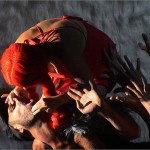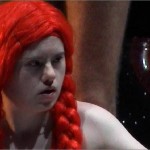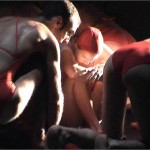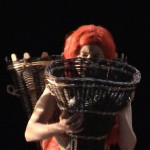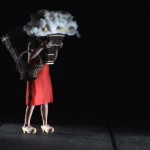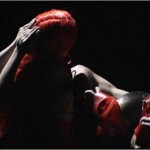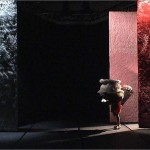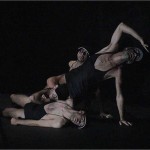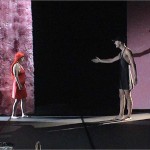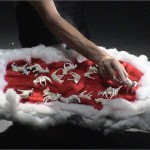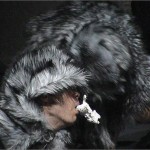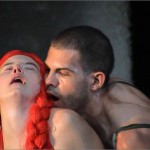
LITTLE RED RIDING HOOD
The show has been presented in many international festivals including: Nature Gods Theater Festival (2003), T.I.S. Festival of Social Interactions in Bologna (2003), E.T.I. Il Vascello Theater in Rome (2004).
Third work of the tetralogy dedicated by Lenz Refractions to the fairy tales of the Brothers Grimm, Little Red Riding Hood is the representation of the metamorphic journey of the fairy-tale hero. In the scene of tactile-chromatic vertigo, the red girl chooses the sensorial deviation to nourish herself and be nourishment for the unknown scenic body.
Red Shadows
On the path of the Beautiful and the Scary by Francesco Pititto
“In the fairy tale, the madman who thinks backwards wins, turns the masks upside down, discerns the secret thread in the plot, in the melody the inexplicable play of echoes; that moves with ecstatic precision in the labyrinth of formulas, numbers, antifone, rituals common to the gospels, to the fairy tale, to poetry. He thinks he is the saint, to walking on the water, to the walls crossed by an ardent spirit. Credit, like the poet, to the word: therefore create with it, he draws concrete wonders from it. And in my God I will cross the wall.”
This is what Cristina Campo writes “The unforgivables”. Campo's writings are diamonds scattered along the paths of pure words. The fairy tale is a search for the word, the word creates life, the word is body. The word commands respect, fear, the memory. The word brings the past to life. Even the silent word speaks. Silence rings. The void is full/full of signs. The word makes dreams come alive. The word is always with us, accompanies us. Like the shadow. The fairy tale is a shadow. Anti-matter lurks in the shadows, the anti-body, the anti-word. The little girl with the little red hood drags the shadows of her fears, of their desires, of their difference. Shadows are cubs of men attracted by the smell of Beauty. Inexperienced cubs dressed in red led by the old graying wolf. Curiosity, research, hunting unknown prey: these instincts move them. The shadow is colored red because red is the color of heat. The imagination is a burning fire, the image is its tongue of flame. The red shadows chase, they pursue the ambitious goal of becoming a body themselves, materia, word. They implode the little girl dressed in red, swallowing her into her belly, in the bottomless bottom. They spit it back into the world transformed into a creature tailored to their needs. Little Red Riding Hood is now the shadow of her own self, half woman, half wolf, half moon and full actress.
Chromatic mechanics
Rotkäppchen by Grimm for Maria Federica Maestri
Understanding.
Conjugations of fear and violence in the crooked path of the little red girl. Disturbance of food and sex in the forest dominated by the gray wolf. Sacrifice of both to keep faith with the Christian law and table. Fear of childhood death and terror of adult life trap the hooded woman in her blushes. Hood that veils the modesty of feeling the passion of cake, masquerade. The seemingly doomed little girl is curious to swallow what food can no longer give. She renounces her duty and is ready to die alone in the black darkness, just to touch what the big eyes hide, ears, mani, mouth. The red omen of blood is fulfilled in the hungry leap, in the prey body, in the bottom of the desired wolf.
Obtainment.
In broken and separate additions, the chromatic surfaces are the evolutionary mechanics of the fairy-tale scene. The set is black occlusion, it is moral blindness, it is the black side of the human disc. United by nature to the other side, the red one, dramatic artery access, compensating exteriority that stands in the center to pronounce the cut of the acute-angle field. Identical in hairy absoluteness, dark and light are recognized as plasters of the living and the dead. The light insinuates itself into the darkness and reveals the fleece of every rubbing step. The path flows through the white sequence, of narrative desolation, visual color blindness of the red kingdom. Suspended in the black are the plastered mummies of sheep and lambs piled up in the mortuary to which the little girl is destined. Lonely they show themselves the pizza of Son of God-Mother, that tastes like bread and blood, and the cake prepared for the benefit of the genetic colonnade. Father God-Old Mother is refreshed by bulges of soured foam dripping with artificial chantilly, inedible food of eternity.
Theme Variation Intermezzo by Adriano Engelbrecht
The musical development of Rotkäppchen is entrusted to the piano and the incessant loop of a continuous bass which regulates the rhythmic rhythm of the entire fairy tale. The progression of the dramaturgical scenes is always anticipated by the melodic variation of the piano theme to which it contrasts, in the form of an interlude, the electro-rock sound of the Hunters' entrance and the shadowy and almost trip-hop sound of Little Red Riding Hood obsessively chased by the foreign body of her own shadow. He reigns over everything, rhythmically sovereign, the pressing narration of the mother tongue in a mother's voice as if to reiterate the all-female genealogy of the fairy-tale Grandmother-Mother-Granddaughter lineage. The only grace of a pizzicato dance pursued by the rectory remains for the men of Lupi and Nonna-Wolf, but well recognized, shadow of repeated low sounds.
LITTLE RED RIDING HOOD
from Rotkäppchen by the Brothers Grimm
translation | playwriting | regia || Francesco Pititto
scene |costumes | visual elements || Maria Federica Masters
musica || Adrian Engelbrecht | Andrew Azzali
voice-over || Annegret Engelbrecht
interpreters || Adrian Engelbrecht | Joseph Impresable | Sara Monferdini | Matthew Ramponi | Alessandro Sciarroni
light design || Rocco Giansante
production || Lenz Refractions
first || Duse Theatre, Theater Festival of Social Interactions, Bologna, 2003
duration || 60 minutes
The show has been presented in many international festivals including: Nature Gods Theater Festival (2003), T.I.S. Festival of Social Interactions in Bologna (2003), E.T.I. Il Vascello Theater in Rome (2004).







